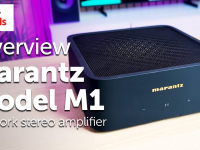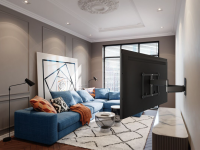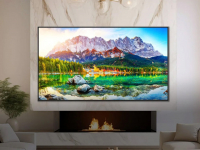
High-end mini-systems have ordinarily been few and far between, with most manufacturers preferring to plump for separate components after certain price points, rather than attempt to shoehorn everything into one box. But as technology continues to both improve and shrink in size, and with formats such as CD taking something of a backseat in recent years, a few brands are starting to reassess their take on the humble mini-system. One such company is Audiolab, and their M-One is their latest attempt at showing that little boxes can still offer big performance.
Housed in the same casework as their M-DAC+, the petite M-One is a classic ‘shoebox’ style mini-system, but one that offers a more modern take on the category. So, rather than having the aforementioned CD drive, the M-One focuses on Bluetooth connectivity, as well as USB connectivity for compatible devices amongst other connections. To be more specific, the M-One offers USB support for playback of files up to a whopping 32-bit/384kHz sampling rate, with support for fledgling (well, now that it’s not called SACD, anyway!) digital format, DSD also available up to DSD256. This focus on Hi-Res audio shows first and foremost who Audiolab are aiming the M-One at with Hi-Res audio, or even just playback from a PC or laptop, really starting to gain traction in hi-fi these days.
For those with other devices they’d like to connect, the M-One also offers optical, coaxial, two sets of RCA sockets and even a separate USB input specifically for Apple products. Bluetooth AptX allows compatible devices (think Android-based  equipment) a means of wireless connectivity to make up for this lack of USB support, offering much better sound quality than previous Bluetooth iterations.
equipment) a means of wireless connectivity to make up for this lack of USB support, offering much better sound quality than previous Bluetooth iterations.
Of course, without an amplifier built in, the M-One would just be a DAC, and Audiolab have managed to squeeze a powerful amp stage in here. Rated at 40 watts per channel into 8 ohms, 60 into 4 ohms, which is definitely above the standard for this type of product, particularly as the amp uses a toroidal transformer and a Class AB setup, rather than the digital amplification often found in mini-systems, meaning a cleaner supply of power in the first place. A headphone output rounds things out, an absolute must these days for products that feature a good quality DAC stage given the ubiquity of high-end headphones and headphone listening in general.
And that amplifier, coupled with such a high-quality DAC stage, helps the M-One to really perform at a top level. Wanting to match it with speakers of both a high quality and a space-saving cabinet size, we chose the Monitor Audio Silver 1, but when we scaled up to something larger, the M-One continued to offer fantastic sound.
Most of our listening was via laptop into the USB socket or through Bluetooth, and when dealing with files of almost any quality, the M-One performed brilliantly. From low-resolution MP3 files up to DSD releases, it offered a crisp presentation of vocals without being harsh, and gave a wide and impressively deep soundstage.
Kicking things off with Time Out of Mind, the 1997 Bob Dylan album that saw a fantastic return to form after a few less-than-stellar efforts. Produced by Daniel Lanois (most famous for his work with U2), the album is a dark and brooding masterpiece, with Dylan’s weathered vocal backed by sympathetic playing from his long-time band. Lanois’ production is open and airy, but still has an almost haunting quality that makes for a melancholy listen. Opener Love Sick offers up a  perfect take on what’s to come. Dylan’s vocal comes across seemingly both exhausted and vitriolic, worn down by the years, whilst his band, equally weary in their playing style, add just enough to carry this late night tale through to its end. Everything was presented wonderfully by the M-One, with a real sense of space around the individual members of the band, and Dylan easy to follow.
perfect take on what’s to come. Dylan’s vocal comes across seemingly both exhausted and vitriolic, worn down by the years, whilst his band, equally weary in their playing style, add just enough to carry this late night tale through to its end. Everything was presented wonderfully by the M-One, with a real sense of space around the individual members of the band, and Dylan easy to follow.
Switching to something a bit more upbeat with Daft Punk’s Alive 1997 showed the M-One was able to handle pacing and rhythm with similar verve. The precursor to the modern Daft Punk set, Alive 1997 was recorded in Birmingham in 1997 (obviously!) and features only material from their first album. Whilst the duo certainly filled the first album with banging house tunes, the live versions take these tracks notches up the BPM, putting us more in techno-territory. The M-One lapped this up, heading out the blocks with Da Funk and never looking back as the intensity increased. Bass was solid, with plenty of impact and heft, and the live atmosphere also came across nicely. The dynamics of each track really shone, with plenty of energy on tap, there was really nothing laid back about how the M-One approached music. Again, for a system of its size, the results were very pleasing indeed.
Further listening showed that the Audiolab really didn’t have much in the way of a preference over what it was playing back. Skipping through genres showed the M-One to have a very even-handed approach to playback, rocking along when called upon, easing off the accelerator when things quietened down, but always allowing the music to shine. Even for a full-size system, the sound quality on offer would be impressive. For a mini-system, it’s downright fantastic, easily shaking off any stigma that may still linger from hi-fi days past. Those short of space would be very much recommended to check out Audiolab’s latest little wonder.
Shop with Richer Sounds today.
Author – Chris, Liverpool store





